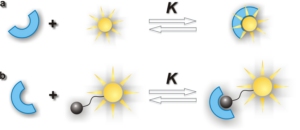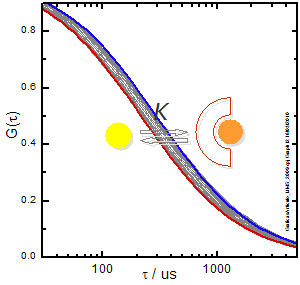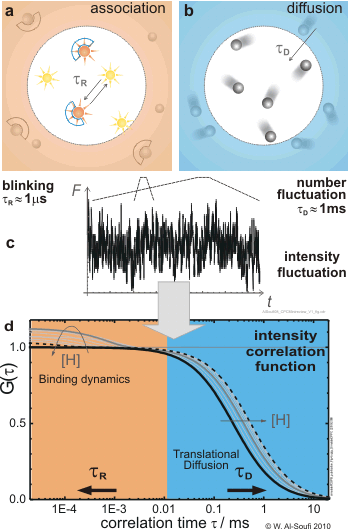Fluorescence Correlation Spectroscopy (FCS) is a powerful single molecule technique for the study of the stability and the association dynamics of supramolecular systems and, in particular, of host-guest inclusion complexes. With FCS the host-guest binding equilibrium constant is determined analysing the variation in the diffusion coefficient of the fluorescent guest or host with no need for a change in the photophysical properties of the fluorescent probe. FCS gives also access to the association/dissociation rate constants of the host-guest inclusion providing that the fluorescence intensity of host or guest changes upon complexation.
Binding affinity by FCS
The understanding and the design of supramolecular systems requires a detailed physicochemical characterization with respect to stoichiometry, affinity, structure, heterogeneity and dynamics, studies which are in general very challenging.
Fluorescence spectroscopy is a very successful technique for these studies because of its high sensitivity and selectivity. However, for standard fluorescence spectroscopic techniques great effort has to be dedicated to the design and synthesis of a fluorescent molecular system which presents a significant change in some of its spectroscopic properties upon binding (quantum yield, spectral shift, lifetime, anisotropy, etc.).
Fluorescence Correlation Spectroscopy (FCS) analyses the variation in the diffusion coefficient of a fluorescently labeled subunit of a supramolecular assembly due to the increase in the molecular weight upon binding to other units (see figure). For these studies the fluorescent label itself needs not to change its spectroscopic properties, which relaxes the conditions imposed on the fluorescent molecular system so that bright and photostable dyes can be attached at convenient positions in the subunits.

1 a) The binding affinity between guest and host is determined from the increase in the molecular weight of the fluorescent guest upon binding.

1 b) Higher molecular weight increases the transit time (diffusion time) across the sample volume. The autocorrelation curves of the intensity fluctuation shift to longer times.
 1 c) FCS Titration. The increase in the mean diffusion (transit) time of a fluorescently labeled-guest on the addition of host allows one to determine the stoichiometry and the affinity of the binding.
1 c) FCS Titration. The increase in the mean diffusion (transit) time of a fluorescently labeled-guest on the addition of host allows one to determine the stoichiometry and the affinity of the binding.
Binding Dynamics by FCS
 The rate constants of association and dissociation of a fluorescently labeled subunit (guest, ligand) to a supramolecular assembly (host, receptor) can be determined by Fluorescence Correlation Spectroscopy (FCS).
The rate constants of association and dissociation of a fluorescently labeled subunit (guest, ligand) to a supramolecular assembly (host, receptor) can be determined by Fluorescence Correlation Spectroscopy (FCS).
In the case of fast supramolecular binding dynamics the guest associates and dissociates (binds and unbinds) many times during its transit through the sample volume of a FCS microscope (Figure a).
In order to detect the binding dynamics, the guest has to present different fluorescence properties (brightness, lifetime or anisotropy) between its free and bound states. In that case the binding dynamics introduces fast intensity fluctuations in the detected fluorescence with a typical correlation time given by the relaxation rate constant of the association-dissociation process (Figure b).
In the case of sufficiently high contrast in the brightness, an additional shoulder is observed in the intensity autocorrelation which changes its amplitude and decay time in a characteristic manner depending on the host concentration. Fits to the correlation curves allow one to determine the relaxation rate constant of the binding dynamics (Figure c).



